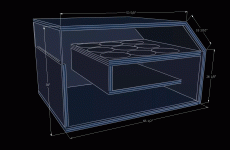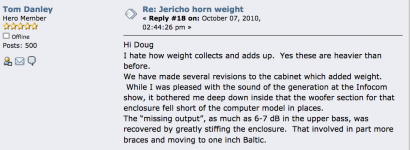Lol, why the model looks like a BASS guitar!
In a dual opposed roar I enter the squeezed down CSA to mimic the real aftect slightly? Between the magnets the occupied volume as CSA missing in that areas length (fudging it) sorta...
this is important. because VAS is a lie in these instances otherwise. we must promote the ability for the sim to 'see' the area of air its feeling and displacing into surrounding. its two sides of the cone... its cone control, its not moving to cool so much either... we must protect our equipment to play hard safely. VAS is already a horribly misused, mismeasured TS parameter thats not in our favor as a high order vented. not the sealed in any way or lump summed casualty of vented qw.... i believe certain parts of a frequency played in a variety of music and the output level used can and will cause helmholtz or otherwise in the sections of the ROAR, HF in a PARAFLEX, especially the alternate offset version, and in a translfex, amongst even folded and twisted MLTLs its all dangling in the musical output level the response only hints at the bulge or the void.. (phase vector sums at the collision in SPL, crack or bulge,constructive/destructive interference...we both have seen lots i imagine?) in higher order cabs it shows up on the amp end at frequencies in particular too....efficient is a great look at one aspect of many, but on real scenario i create an under powered source that will go into protect even... testbench is what it is... and sling a tone generator not a sweep or pink noise at these things... its dangerous and harming equipment is not something i can say i didnt do... but you have an awesome cabinet design(as you know) and if tuned too low(as you know) the smell of excursion isnt just a voice coil adhesive, if its not a bad tune (too low), its time for a proper powersource to be given to a proper driver for these. its a real sign of something special when you can se the acoustical magic transfer it wants in energy at areas in the cabinet makiing them!! roar can be crazy in aggresive layouts and holy shooot is it fun to look!! or dream! baby steps were the plan. this is my fourth high order 8th cab. one transflex and two para. a isobsaric 6th and now i will ROAR
all of that to lead up to a roar question: would it bealright if i run a few sims by you for approval and at your leusure? maybe you select the 'best' and make any changes youd suggest?
all of that to lead up to a roar question: would it be alright if i run a few sims by you for approval and at your leisure? maybe you select the 'best' and make any changes you'd suggest?
You should pose this question in the ROAR and Super Planar threads. I'm a simple guy. I like straight flared TH or TQWP/TQWT for ease of build.
Also, check out MMJ's Facebook link. The enclosures in that group are off the hook! You don't need a FB account to view the pics.
Matthew Morgan is more than a speaker nerd. He is what everyone in speakers should aim To be. I don’t mean paraflex alone or even a particular box. I mean everything, that dude is special, and he creates that in other people I think too. Spreads around him like energy in sound? Ironic. And iconic.
But aside from
Wild and loud, I’m transflex or tapped mltl maybe? I don’t like names because they are qw pipes to me.. tapped, but that’s all quickly confusing because I can’t even begin to say what the name might really be? Offset voight tapped an flared massloaded 8th order bass cannon vented reflex pipe? Lol! Maybe?kinda? But there’s paraflex and mltl and roar and tham in lotsvofbyhings I have made but don’t know what they are?
But aside from
Wild and loud, I’m transflex or tapped mltl maybe? I don’t like names because they are qw pipes to me.. tapped, but that’s all quickly confusing because I can’t even begin to say what the name might really be? Offset voight tapped an flared massloaded 8th order bass cannon vented reflex pipe? Lol! Maybe?kinda? But there’s paraflex and mltl and roar and tham in lotsvofbyhings I have made but don’t know what they are?
Attachments
Last edited:
Agree about MMJ!
The names stem from modeling in HR with TH function.
Positive flare TH = conventional TH.
Straight flare TH = tapped quarter wave tube or pipe (TQWT/TQWP).
Negative flare TH = tapped tapered quarter wave tube or pipe (T-TQWT/T-TQWP).
alright. im gonna try to force this into my pea sized brain if it will stick i hope
THAM 15 + the box 15LB075-UW4; vs. JBell SS15
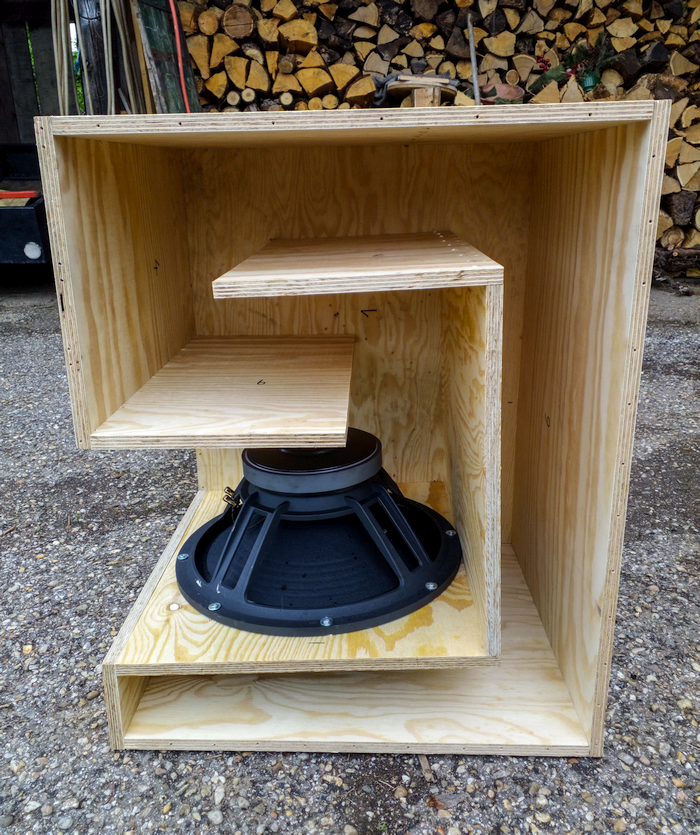
My measurements for the SS15 can be found here.
Measurements done with:
Software: ARTA, STEPS & LIMP
Soundcard: Creative X-Fi USB HD
Pre-Amp: IMG MPA-102
Microphone: Isemcon EMX-7150 (Class 1 FR; calibrated; Max. SPL 135 dB @ 1% THD)
SPL Calibrator: Isemcon SC-1 (Class 2, temperature- and battery-compensated; Accuracy +/- 0,5 dB)
Amp: Sinbosen FP10000Q V2; limited to 50 Vrms, equaling 500 watts at the impedance minimum of these boxes
ARTA Measurement Box
First, here's a little video cut of the Max. SPL measurement in ARTA / STEPS; I've never seen this documented anywhere, so I thought I might as well do it:
ARTA / STEPS distortion limited SPL demonstration - THAM 15
Frequency response / sensitivity 2m GPM scaled to 1m, 2V = 1Watt for a 4 ohm chassis; black THAM15, green JBell SS15; at the left bottom impedance for the THAM:
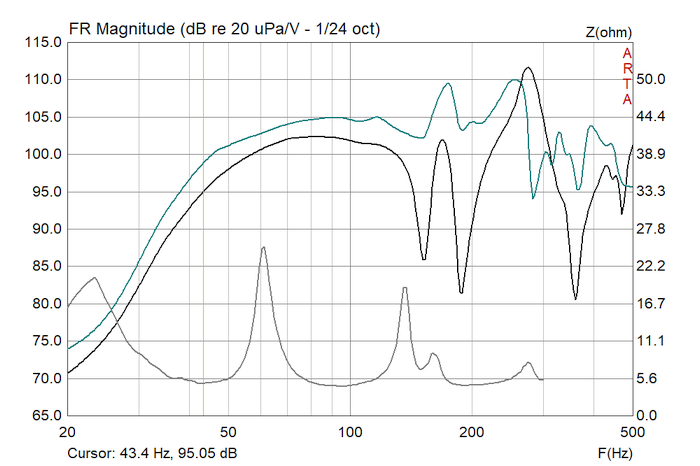
Max. SPL @ 10% THD, 2m GPM scaled to 1m; black THAM15, green JBell SS15, and for further comparison in blue a DB Technologies S118R (2500€ commercial 18" bassreflex):

The max. SPL down low would probably look on par with the SS15, if the driver wasn't electrically / thermally limited. The enclosure would do even better specifically with a chassis with a larger / more durable voice coil.
All in all: solid box, Anders!

My measurements for the SS15 can be found here.
Measurements done with:
Software: ARTA, STEPS & LIMP
Soundcard: Creative X-Fi USB HD
Pre-Amp: IMG MPA-102
Microphone: Isemcon EMX-7150 (Class 1 FR; calibrated; Max. SPL 135 dB @ 1% THD)
SPL Calibrator: Isemcon SC-1 (Class 2, temperature- and battery-compensated; Accuracy +/- 0,5 dB)
Amp: Sinbosen FP10000Q V2; limited to 50 Vrms, equaling 500 watts at the impedance minimum of these boxes
ARTA Measurement Box
First, here's a little video cut of the Max. SPL measurement in ARTA / STEPS; I've never seen this documented anywhere, so I thought I might as well do it:
ARTA / STEPS distortion limited SPL demonstration - THAM 15
Frequency response / sensitivity 2m GPM scaled to 1m, 2V = 1Watt for a 4 ohm chassis; black THAM15, green JBell SS15; at the left bottom impedance for the THAM:

Max. SPL @ 10% THD, 2m GPM scaled to 1m; black THAM15, green JBell SS15, and for further comparison in blue a DB Technologies S118R (2500€ commercial 18" bassreflex):

The max. SPL down low would probably look on par with the SS15, if the driver wasn't electrically / thermally limited. The enclosure would do even better specifically with a chassis with a larger / more durable voice coil.
All in all: solid box, Anders!

Great data stoneeh, thanks!
The THAM15 was designed to be compact, easy to build, forgiving towards different drivers, and offer decent performance in a usable range, a very "diy" design approach in other words.
In that light it will newer, and was never meant to, take on designs balanced more towards high performance rather then small size, we took a swing at that with the ROAR series instead.
So if we look at it from a external volume perspective we see the following, as a complement to the great data supplied by you, again many thanks!
DB technologies S118R -> 220dm3
SS15 -> 247dm3 (unsure if this is correct)
THAM15 -> 187dm3
Meaning that the THAM15 is 15% or 33dm3 smaller than the DB S118R, and 24% or 60dm3 smaller than the SS15 (again unsure), and in that view I'm happy how it managed in the comparison.
The THAM15 was designed to be compact, easy to build, forgiving towards different drivers, and offer decent performance in a usable range, a very "diy" design approach in other words.
In that light it will newer, and was never meant to, take on designs balanced more towards high performance rather then small size, we took a swing at that with the ROAR series instead.
So if we look at it from a external volume perspective we see the following, as a complement to the great data supplied by you, again many thanks!
DB technologies S118R -> 220dm3
SS15 -> 247dm3 (unsure if this is correct)
THAM15 -> 187dm3
Meaning that the THAM15 is 15% or 33dm3 smaller than the DB S118R, and 24% or 60dm3 smaller than the SS15 (again unsure), and in that view I'm happy how it managed in the comparison.
Stoneeh,Max. SPL @ 10% THD, 2m GPM scaled to 1m; black THAM15, green JBell SS15, and for further comparison in blue a DB Technologies S118R (2500€ commercial 18" bassreflex):
The max. SPL down low would probably look on par with the SS15, if the driver wasn't electrically / thermally limited. The enclosure would do even better specifically with a chassis with a larger / more durable voice coil.
All in all: solid box, Anders!
15LB075-UW4 has an Xmax of only 4mm.
The Max. SPL @ 10% THD is likely limited more by low Xmax than the low thermal capabilities (300w IEC noise) of the 15LB075-UW4.
Using Anders Martinsson's driver of choice for the THAM15, the B&C 15TBX100 (Xmax 9mm, Xvar 11mm, 1000w) though the sensitivity would drop, I'd expect you would find the Max. SPL @ 10% THD exceeding the 15LB075-UW4 by 6dB or more.
That would put it's level above the Max. SPL @ 10% of the DB Technologies S118R, though your build's omission of bracing may also limit upper passband (60-125Hz) output at high drive levels.
Cheers,
Art
Last edited:
I sometimes wonder how this design would perform if loaded with a bit more modern high performance drivers like the SW or DS from B&C, one will most likely benefit from rounding of all sharp all inner corners and perhaps even up the bracing a bit, turbulennce wise think it would manage fairly well given the rather generous path area, the max SPL to size ratio (dB/dm3) would be interesting to see.
weltersys: as documented above, the max. SPL test was limited to 50 Volts (Vrms) at the amp, which translates to 500 watts at the measured impedance minimum of 5 ohm. (I chose a value a little higher than the chassis' rated power value of 300 watts, because from experience speakers will be able to handle a little more for short bursts.)
The VPL (voltage peak limiter) of the Lab FP series will be restricting output voltage at the set value. If input is added beyond that, the output will transition from a sine wave to a square wave -> added harmonics.
In a distortion limited max. SPL run, the VPL being hit would thus show up as distortion increasing without SPL increasing; because above the amp's VPL, added input would yield no further amplification, just added distortion.
This can be observed at certain frequencies, especially around the enclosure's fb, in the video demonstration I provided.
So you could have verified or refuted your assumption of an electrical vs. mechanical limit for yourself. Just as you've amply demonstrated in the SS15 thread though, your willingness to speculate and blindly mouth off will greatly exceed your willingness to obtain basic education on a subject, and read and understand the information that has been provided.
As for the rest of your statement - yes indeed, a more potent chassis would provide higher output. Thanks for stating the obvious.
Ad bracing: my own tests and those of others show little influence of bracing on max. SPL - somewhere in the area of less than 1 dB even with much stronger chassis than the 15LB075.
Any difference would actually show itself in the area around the resonator's tuning, where there is the most pressure on the enclosure. Your assumption that bracing would mostly benefit upper bass frequencies is, again, ridiculous.
(That is not to say I would not recommend bracing in general - it can/will reduce annoying creaks and such, and the box might subjectively sound a bit more defined at higher outputs.)
Anders: I think your design is great The THAM15 has almost the same basic response as the much larger (the version I built has an external volume of 267l) SS15. The THAM just has a lower sensitivity.
The THAM15 has almost the same basic response as the much larger (the version I built has an external volume of 267l) SS15. The THAM just has a lower sensitivity.
Lower sensitivity doesn't necessarly mean a lower max. SPL - it just means you have to add more power to get there.
The 15TBX100, which you recommend for this cabinet, has about 60% more linear excursion ((25mm hvc - 12mm hg) / 2 = 6,5mm), but more than 200% more power handling as the 15LB075, and should perfectly accomplish that.
What should be taken away from my data is that this little box goes plenty loud and low, and at less than 150€ total cost can almost match a 18" bassreflex with 3x its amping and close to 20x its price - how awesome is that!
Btw., right now I've already installed the 15LB100 into the cabinet, which has a 4" instead of a 3" vc and should be quite a bit more potent.
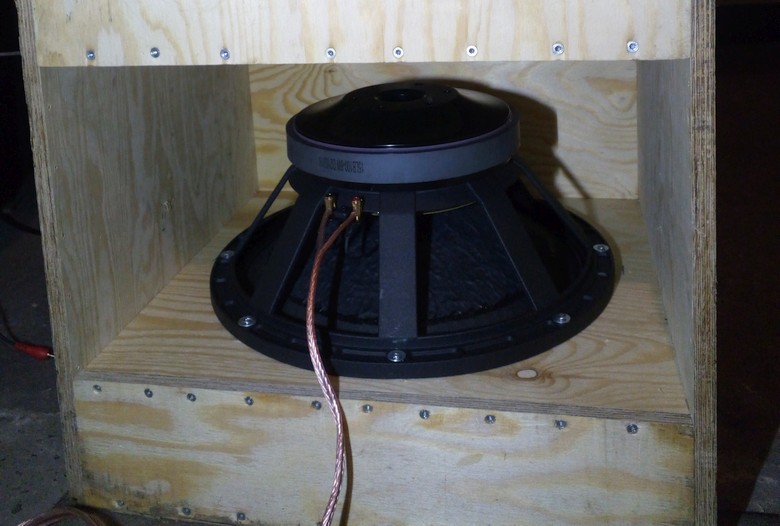
The VPL (voltage peak limiter) of the Lab FP series will be restricting output voltage at the set value. If input is added beyond that, the output will transition from a sine wave to a square wave -> added harmonics.
In a distortion limited max. SPL run, the VPL being hit would thus show up as distortion increasing without SPL increasing; because above the amp's VPL, added input would yield no further amplification, just added distortion.
This can be observed at certain frequencies, especially around the enclosure's fb, in the video demonstration I provided.
So you could have verified or refuted your assumption of an electrical vs. mechanical limit for yourself. Just as you've amply demonstrated in the SS15 thread though, your willingness to speculate and blindly mouth off will greatly exceed your willingness to obtain basic education on a subject, and read and understand the information that has been provided.
As for the rest of your statement - yes indeed, a more potent chassis would provide higher output. Thanks for stating the obvious.
Ad bracing: my own tests and those of others show little influence of bracing on max. SPL - somewhere in the area of less than 1 dB even with much stronger chassis than the 15LB075.
Any difference would actually show itself in the area around the resonator's tuning, where there is the most pressure on the enclosure. Your assumption that bracing would mostly benefit upper bass frequencies is, again, ridiculous.
(That is not to say I would not recommend bracing in general - it can/will reduce annoying creaks and such, and the box might subjectively sound a bit more defined at higher outputs.)
Anders: I think your design is great
 The THAM15 has almost the same basic response as the much larger (the version I built has an external volume of 267l) SS15. The THAM just has a lower sensitivity.
The THAM15 has almost the same basic response as the much larger (the version I built has an external volume of 267l) SS15. The THAM just has a lower sensitivity.Lower sensitivity doesn't necessarly mean a lower max. SPL - it just means you have to add more power to get there.
The 15TBX100, which you recommend for this cabinet, has about 60% more linear excursion ((25mm hvc - 12mm hg) / 2 = 6,5mm), but more than 200% more power handling as the 15LB075, and should perfectly accomplish that.
What should be taken away from my data is that this little box goes plenty loud and low, and at less than 150€ total cost can almost match a 18" bassreflex with 3x its amping and close to 20x its price - how awesome is that!
Btw., right now I've already installed the 15LB100 into the cabinet, which has a 4" instead of a 3" vc and should be quite a bit more potent.

stoneeh - It is a 12 year old design by publication, but the actual design was finalized one year before that, in 2D no less (Autocad 2002), and to top it all of it turns out I had the simulation wrong, to think that after all this time it still manages to get some attention is very rewarding, thank you for sharing your findings, measurements and opinions.
Art's feedback is still relevant as I see it given that a more capable driver would have enabled a higher VPL threshold for the measurements, still the measurements are very welcome, as with everything one needs to see and understand the context, in this case a consideration taken for the driver used, which is all well and good, to take the driver beyond its capabilities would have introduced uncertainty in the results.
Art's feedback is still relevant as I see it given that a more capable driver would have enabled a higher VPL threshold for the measurements, still the measurements are very welcome, as with everything one needs to see and understand the context, in this case a consideration taken for the driver used, which is all well and good, to take the driver beyond its capabilities would have introduced uncertainty in the results.
Taking the driver beyond its thermal capabilities would have introduced one certainty in the result: there would be no result  - the driver would have been destroyed.
- the driver would have been destroyed.
As far as the benefit of a more potent driver, I already stated that in my initial post (second to last sentence):
There is no value in someone repeating the same statement in other words. As I said however, there would be value in actually reading and trying to understand content before replying to it.
I'm glad the measurements are appreciated. I will be testing the 15LB100 soon. I plan to allow it close to 1000 watts, which might change the picture a bit. I doubt I will be posting further results publically - write me a PN, Anders, if you're want to see them.
As far as the benefit of a more potent driver, I already stated that in my initial post (second to last sentence):
The max. SPL down low would probably look on par with the SS15, if the driver wasn't electrically / thermally limited. The enclosure would do even better specifically with a chassis with a larger / more durable voice coil.
There is no value in someone repeating the same statement in other words. As I said however, there would be value in actually reading and trying to understand content before replying to it.
I'm glad the measurements are appreciated. I will be testing the 15LB100 soon. I plan to allow it close to 1000 watts, which might change the picture a bit. I doubt I will be posting further results publically - write me a PN, Anders, if you're want to see them.
That is fair, I wich I had the equipment, space and time to perform similar measurements, in that case I would have liked to plot 1,3 and 10% THD SPL levels to spot the trend of where the limitations show up.
Regarding the bracing, a loss in SPL is given as the energy is transformed I to vibrating the panels rather than.moving the air, but one should also see a distortion increase, correct? That in a measurement like this may limit the SPL prematurely, or have you measured this and found that it is not the case?
Regarding the bracing, a loss in SPL is given as the energy is transformed I to vibrating the panels rather than.moving the air, but one should also see a distortion increase, correct? That in a measurement like this may limit the SPL prematurely, or have you measured this and found that it is not the case?
That's a pretty good summary actually. You do need equipment as well as space as well as a whole lot of time - rushing it is NOT compatible with producing accurate results.
For distortion limited SPL measurements, you have to confirm every single element in the signal chain does not add its own distortions. With the pre-amp for example it's tricky to get it right - set it to too low a level, its noisefloor will influence the measurement - set it to too high a level, it will overdrive / clip. Similar with the soundcard used. Similar with the amp.
The German magazine Production Partner regularly measures boxes with a 3% vs 10% distortion limit. They have some free tests available on their website. If you're interested in the subject, look them up.
I actually did add one brace to the (inner side of the) back wall of the THAM; after taking the picture, but before testing. That's a very large unbraced area otherwise, so I just pro-actively put a brace there - just because it doesn't hurt - and because it might sound slighty better in listening tests.
- and because it might sound slighty better in listening tests.
I've done comparisons. The difference between braced and unbraced is more audible than measureable, and is more that of a more defined sound than higher maximum output. It seems counter-intuitive, but there's almost zero difference in measured max. SPL, even with a relatively unstable material such as chip boards.
For distortion limited SPL measurements, you have to confirm every single element in the signal chain does not add its own distortions. With the pre-amp for example it's tricky to get it right - set it to too low a level, its noisefloor will influence the measurement - set it to too high a level, it will overdrive / clip. Similar with the soundcard used. Similar with the amp.
The German magazine Production Partner regularly measures boxes with a 3% vs 10% distortion limit. They have some free tests available on their website. If you're interested in the subject, look them up.
I actually did add one brace to the (inner side of the) back wall of the THAM; after taking the picture, but before testing. That's a very large unbraced area otherwise, so I just pro-actively put a brace there - just because it doesn't hurt
I've done comparisons. The difference between braced and unbraced is more audible than measureable, and is more that of a more defined sound than higher maximum output. It seems counter-intuitive, but there's almost zero difference in measured max. SPL, even with a relatively unstable material such as chip boards.
It takes alot to do it right and getting it right, hence my gratitude for the efforts put in by you, depending on where you are in the world one could also add weather conditions to the list 
There are alot of excellent diy designs, by any standard, and we all ove alot to David for the software and our forum members for sharing their knowledge and their willingness to help.
I believe that financial and facility resources apart the collective knowledge and know-how on this forum could rival that of established brands, and it shows.
This is indeed a very rewarding interest to have, in my case for over 30 years now, and I'm starting to realize that it will be a lifelong condition
Try, fail, share, learn, grow
There are alot of excellent diy designs, by any standard, and we all ove alot to David for the software and our forum members for sharing their knowledge and their willingness to help.
I believe that financial and facility resources apart the collective knowledge and know-how on this forum could rival that of established brands, and it shows.
This is indeed a very rewarding interest to have, in my case for over 30 years now, and I'm starting to realize that it will be a lifelong condition
Try, fail, share, learn, grow
Stoneeh,The max. SPL down low would probably look on par with the SS15, if the driver wasn't electrically / thermally limited. The enclosure would do even better specifically with a chassis with a larger / more durable voice coil.
weltersys: as documented above, the max. SPL test was limited to 50 Volts (Vrms) at the amp, which translates to 500 watts at the measured impedance minimum of 5 ohm. (I chose a value a little higher than the chassis' rated power value of 300 watts, because from experience speakers will be able to handle a little more for short bursts.)
The VPL (voltage peak limiter) of the Lab FP series will be restricting output voltage at the set value. If input is added beyond that, the output will transition from a sine wave to a square wave -> added harmonics.
So you could have verified or refuted your assumption of an electrical vs. mechanical limit for yourself.
Ad bracing: my own tests and those of others show little influence of bracing on max. SPL - somewhere in the area of less than 1 dB even with much stronger chassis than the 15LB075.
Any difference would actually show itself in the area around the resonator's tuning, where there is the most pressure on the enclosure. Your assumption that bracing would mostly benefit upper bass frequencies is, again, ridiculous.
Thanks for the clarification, I did not understand that when you wrote "if the driver wasn't electrically / thermally limited" you meant the amplifier was set to limit voltage.
Regarding my "ridiculous assumption" about bracing, tests done by Tom Danley (the inventor of the "Tapped Horn" designation we use for the Tham15, SS15, etc.) support my statement.
Jehrico horn
Reply #18:
“I hate how weight collects and adds up. Yes these are heavier than before.
We have made several revisions to the cabinet which added weight. While I was pleased with the sound of the generation at the Infocom show, it bothered me deep down inside that the woofer section for that enclosure fell short of the computer model in places.
The “missing output”, as much as 6-7 dB in the upper bass, was recovered by greatly stiffing the enclosure. That involved in part more braces and moving to one inch Baltic."
At any rate, it would be interesting to see the difference in 10% distortion limited output using a driver that has over double the Xmax of the one you chose to measure.
Keep up the good work!
Art
Attachments
Hey guys. So after some application of seals I've gotten the THAM15 boxes with 15PS100 to perform significantly better.
I'm now trying to figure out the crossover points. @Martinsson said 40 HPF and 140 LPF at 48db/oct preferably. I have the DCX2496 which can do 48db/oct LR and BW, so that seems okay. But I'm trying to figure out the crossover point for my tops. I am running four JBL JRX 212 at the moment (specs are 80-18k at +- 3db), but switching those to a pair of Nexo PS-15 in a few weeks. I'd still like to try it with the JBL's though.
So, long story short. With LR48 crossover, what would be a good point to introduce the tops? I'm sorry for being a newbie in this aspect!
I'm now trying to figure out the crossover points. @Martinsson said 40 HPF and 140 LPF at 48db/oct preferably. I have the DCX2496 which can do 48db/oct LR and BW, so that seems okay. But I'm trying to figure out the crossover point for my tops. I am running four JBL JRX 212 at the moment (specs are 80-18k at +- 3db), but switching those to a pair of Nexo PS-15 in a few weeks. I'd still like to try it with the JBL's though.
So, long story short. With LR48 crossover, what would be a good point to introduce the tops? I'm sorry for being a newbie in this aspect!
Hey everyone, i'm planning on building some THAM15's later this year and was wondering if the size of the driver makes any difference in response since it's "blocking" the exit of the horn. The drivers i want to use are Faital 15XL1400's which are quite large but they seem to be one of the best drivers in terms of response and max spl (atleast according to hornresp).
- Home
- Loudspeakers
- Subwoofers
- THAM15 - a compact 15" tapped horn
